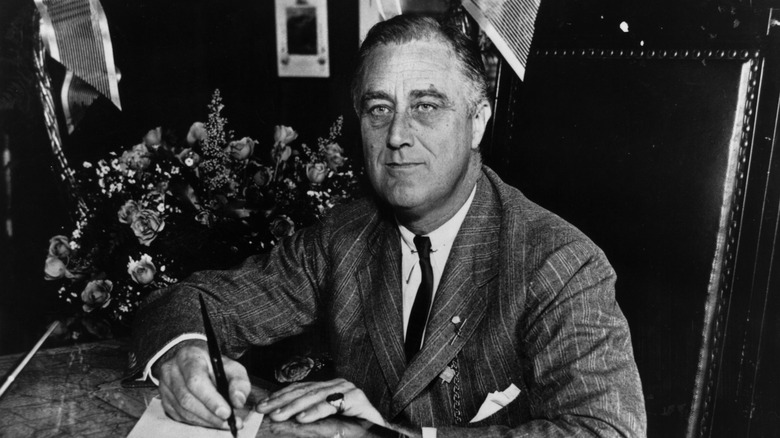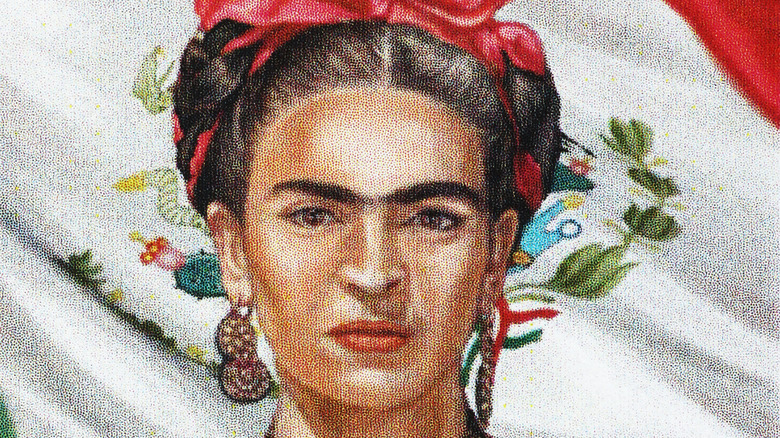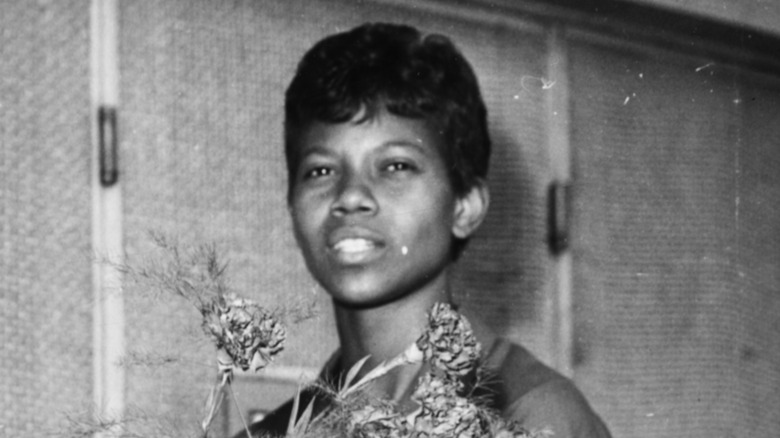Famous People Who Survived Polio
Although Poliomyelitis (polio) has been around for thousands of years, it didn't reach pandemic proportions until the early- to mid-20th century. In the late 1940s, the Centers for Disease Control and Prevention (CDC) estimates that over 35,000 people each year were somewhat incapacitated by polio. According to NPR, by the 1950s, polio was one of the most serious childhood diseases in the country, made even worse by the fact that it was highly contagious.
Children under the age of 5 were more likely to contract polio and more likely to experience lasting consequences because of it. The polio virus attacks the nervous system and .5% of patients develop irreversible paralysis as a result. Up to 10% of paralyzed people would eventually die when their breathing muscles stop working (via World Health Organization).
Those who didn't develop the paralytic form of polio had milder symptoms, which included fever, vomiting, severe headaches and neck pain, muscle weakness, and back pain. Still, even people with minor symptoms were at risk of developing post-polio syndrome years later, resulting in muscle wasting (atrophy) and weakness, ongoing fatigue, and breathing problems (per Mayo Clinic).
The U.S. has been polio-free since 1979, but it still remains endemic in Afghanistan and Pakistan, according to the CDC. In the U.S., many people who survived polio as children still live with the lasting health consequences of the illness.
A US president survived polio
One of the most famous persons to ever survive polio was the 32nd President of the United States, Franklin D. Roosevelt. Roosevelt contracted polio when he was 39 years old. According to the Presidential Library and Museum, Roosevelt was vacationing at the family cottage on Campobello Island when he started complaining of lower back pain and weakness in his legs.
After three days, he could no longer stand or walk. He was eventually diagnosed with polio in August 1921. Roosevelt took up swimming (as his legs could support him in the water) as a form of rehabilitation, regularly visited mineral-rich spring waters (which ended up not helping at all with his paralysis), and would eventually be fitted with leg braces that made it possible to stand up.
FDR used a special wheelchair made up of a dining chair with added wheels. This was an attempt to "minimize" his disability and appear more "normal" to the American people as he resumed his political career and eventually became president. Although the public didn't seem to care much (even though disabilities were a bit of a taboo in the 1920s), Roosevelt always made an effort to be seen walking with the aid of a cane and the support of a helper.
In 1934, FDR created the National Foundation for Infantile Paralysis (which would later become the March of Dimes) and started organizing fundraisers for it, which eventually funded the research for the development of the polio vaccine.
Some very accomplished artists survived polio
Mexican artist Frida Kahlo (above) might have never been a painter if not for polio. When she contracted polio in 1907 at age 6, Kahlo was forced to endure a nine-month-long convalescence and was left with one leg shorter and thinner than the other. This resulted in a limp and bullying by children at school, which in turn caused Kahlo to become isolated and spend a lot of time with her father, an accomplished photographer. This helped developed her love for sketching and the arts (via FridaKahlo.org and Biography).
British science-fiction writer Sir Arthur C. Clarke wrote more than 100 books, but he's best remembered for "2001: A Space Odyssey," which became one of Stanley Kubrick's most famous films (via Biography).
Clarke got sick with polio in 1962, when he was 67 years old. Although the polio attack was severe, he recovered fully and continued to be an active and sporty person, as he had been most of his life (via The New York Times). More than two decades later, in 1984, he developed post-polio syndrome, which causes muscle weakness, extreme tiredness, and pain in the joints. Post-polio syndrome can develop soon or many years after the original illness appears (per Cedars Sinai). Clarke was eventually unable to walk and confined to a wheelchair until his death in 2008 at the age of 90.
Hollywood stars who had polio
In her autobiography ("What Falls Away: A Memoir"), Mia Farrow (above) calls the day when she was diagnosed with polio "the day my childhood ended." It happened the day after her 9th birthday and marked the beginning of a long illness that she remembers included time spent in an iron long, spinal taps, and other wardmates crying and screaming in pain (via New Mobility). Farrow eventually recovered completely and many years later became an advocate for polio vaccination in Africa and adopted a polio survivor from an orphanage in Calcutta, India (per New York Post).
Actor Donald Sutherland battled many illnesses as a child, including rheumatic fever, hepatitis, and polio. He spent months bedridden as a result, which he credits with helping him develop a deep love for reading and eventually acting. According to Biography, one of the first words Sutherland learned to say was "neck," to point out the pain he was feeling as polio was starting to take hold. He recovered well and had no lasting effects from it, except that one of his legs is shorter than the other.
Hollywood director Francis Ford Coppola contracted polio when he was 9 and spent the next year and a half "hiding" at home. In an interview with the Academy of Achievement, Coppola commented that "people were very frightened for their children, so you tended to be isolated. I was paralyzed for a while. And so I basically watched television, and listened to the radio, and played with a tape recorder, and puppets, and my day was made up of those kinds of things."
Famous musicians who once had polio
Both Neil Young and Joni Mitchell contracted polio in 1951, when a major outbreak of the disease infected over 2.500 people in Canada (per Kawartha Now). Five-year-old Young developed symptoms after a day of summer swimming with his father. The pain was so intense and appeared so quickly that the family doctor suspected polio even before Young went to the hospital. He would eventually spend six days in isolation in a polio ward, followed by a long, painful recovery at home that continued until the following spring. Young was partially paralyzed and had to relearn to walk.
Mitchell (pictured above) was 9 when she contracted polio and went into the hospital in October 1951. She was told she would never walk again and would have to spend Christmas at the hospital, so she taught herself to walk by moving up and down the hospital corridor. "I put my arms on these chrome bars, and I pulled myself along to the end ... and then I said, 'Now can I go home?'" (as told in an interview with NPR).
Mitchell did get to go home for Christmas, but had to wear braces and metal-lined boots for a long time as she continued her recovery. When asked about how the experience changed her, Mitchell said she "would've been — I was a good athlete. And I lost all my strength and my speed, so that's another thing that made me more of an artist. So, you know, no doubt the universe is unfolding as it should be."
Other famous polio survivors
Olympic sprint champion Wilma Rudolph (above) contracted pneumonia, scarlet fever, and polio as a young child in the 1940s. She became paralyzed and was told by her doctors she would never walk again. By the age of 12, she was not only walking again, but she had also taken up athletics. At the age of 16, she participated in the 1956 Melbourne Games and won a bronze medal as part of a relay team (via Olympics).
Singer-songwriter Judy Collins contracted polio when she was 10 years old in the 1950s. According to Collins herself, "I had to be isolated in the hospital and I couldn't see my parents. I wasn't worried. For me, polio was like a vacation — I could read all the time" (via The Wall Street Journal). The first phase of the recovery took seven weeks, but three months later, Collins had completely recovered with no lingering effects.
World famous violinist Itzhak Perlman contracted polio at the age of four in his home country of Israel. In an article written for The Jerusalem Post, Perlman himself says he "was very lucky in making a good recovery and learning to walk with crutches. While the virus made normal use of my legs impossible, my hands were spared." Polio kept the musician bedridden for a year, where he spent time playing with a toy violin before getting a real one a year later. By age 17, he was playing in Carnegie Hall (per Village News).





